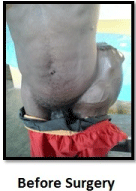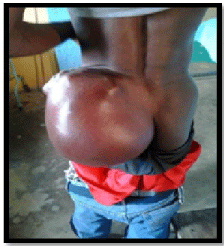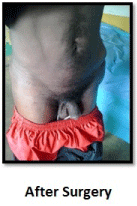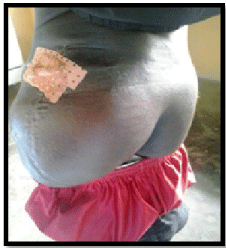Keywords
|
| Giant chondrosarcoma, Chemotherapy, Essential oil, Camphor |
Introduction
|
| Chondrosarcoma is a malignant tumor characterized by the proliferation of chondroblasts producing no bone , which can sometimes developed by metaplasia inside a connective tissue and present a rapid growth of both cartilaginous and connective tissues. Chondrosarcoma is a very rare tumor, two times less frequent than osteosarcoma. It may represent 11-20% of all malignant bone tumors as reported by Unni [1]. It has been found more in males than in female [2]. Some authors have reported a high incidence in young adults [3,4]. Dahlin et al. and Campanacci et al. have reproted it in 4% only of patients below 20 years, 40-47% of patients are above 40 years [1,2]. The most likely diagnosis below 20 years is chondroblastic osteosarcoma. Current management of chondrosarcoma by chemotherapy has been associated with a high rate of failure [5,6], chondrosarcoma tumor’s cells highly expressed the multidrug resistance-1 (mdr-1) responsible of the inefficacy of the chemotherapy. Undifferentiated chondrosarcoma and mesenchymal chondrosarcoma are less resistant to chemotherapy and show some sensitivity [7]. Very large tumors are very difficult to be removed enbloc, with a high rate of local recurrence of 30% compared to 15% for smaller tumors. This recurrence is more with high grade tumors [3]. |
| We are reporting herein the first case of neo-adjuvant chemotherapy associated with external application of camphor based essential oil, followed by radical surgery indicated for a giant chondrosarcoma of the left coxo-femoral and gluteal regions. |
Case report
|
| A 42 years old man was referred to us with a long standing history of multiple hospital visits and admissions for a large mass of the left coxo-gluteal region associated with impotence and swelling of the left lower limb. The tumor has been there for almost 5 years. The mass was occupying the entire left gluteal region up to the inguinal region (Figures 1 and 2). The femoral, popliteal and dorsalis pedal pulses were palpated and were strong. The sensitivity of the limb was also normal. The physical exam showed a very large mass of the left buttock with no sign of trauma or infection measuring 20 cm x 15 cm in the largest dimensions (Figure 1). Laboratory results showed a mild anemia with a hemoglobin of 10 g/dl, a CEA level of 15 ng/ml and a CA 19.9 of 6.8 U/ml. The radiography of the coxal bone did not show any significant abnormalities. There was an increase in the volume of the left buttock soft tissue. The CT scan showed a heterogeneous mass of the left gluteo-iliac region with the suspicion of a fibrosarcoma measuring 145 mm x 161 mm x 184 mm. The MRI imaging documented a malignant tumors of the left gluteal region and this diagnosis was confirmed by the pathological analysis of the incisional biopsy which revealed a grade II chondrosarcoma. |
| The patient was placed on neoadjuvant chemotherapy using Adriamycin 20 mg/m2 associated with ifosfamide 2500 mg/m2` and decarbazine 300 mg/m2 for three days, all of it associated with external massages using a camphor based essential oil with the resultant decreased of the volume of the tumor after 4 cures. |
| The surgical resection was undertaken under general anesthesia after down staging (the tumor mass decreased by 50%) of the tumor by the neoadjuvant treatment enabling surgery and radical resection to be undertaken sparing the sciatic nerve which was totally embedded by the tumor. Post chemotherapy dimensions were 11 cm x 8 cm in the largest dimensions. Post operatively, the patient underwent 2 more cures of chemotherapy using the same protocol. He was discharged home on the 23rd day after surgery with 65% recovery of his left lower limb function. He continues to have physiotherapy and after three months he achieved a 90% recovery of the function of the left lower limb. Six months later he returned to his work in a private plant in Douala. Figures 3 and 4 show the post-operative pictures taken seven months after the surgery. |
Discussion
|
| Chodrosarcoma is defined by the growth of malignant cartilaginous tissue without bone formation. Chondrosarcoma is called primitive when its occurs in a healthy bone and secondary when its complicate an osteogenic exostosis [8,9]. Commons chondrosarcoma can be classified in three grade: In grade I or low grade tumor, the tumor presents a normal cartilaginous tissue appearance surrounded by some area of lamellar bone (these are absent in a benign chondroma); in grade II or intermediary grade tumor, there is a high number of abnormal tumor’s cells with atypia; in grade III or high grade tumor, there are area of large pleomorphic cells, with areas of necrosis and multiples mitosis. The large majority of chondrosarcoma are of grade I and II. Grade III are rare [9]. |
| Local recurrence and distant metastasis are very common with grade II and grade III, although the recurrence rate may vary depending on authors: Pritchard have reported a 6% recurrence rate [9], Evans et al. 11% recurrence rate [10]; Lee et al have found 24% [11]; Ucla et al., have reported a recurrence arte of 27% [4]; Campanacci et al., 28% [2] and Marcove et al., have reported a 33% recurrence rate [11]. |
| Local control of the tumor depend mostly on the type of resection [3,4], radical and extra-tumoral resection is associated with a three time decrease in the recurrence rate [3,4]. Metastases are also common with higher grade tumors (grade II and III) [9]. The local recurrence rate is associated with a higher probability for distant metastasis and theses tumors may need adjuvant chemotherapy associated with the radical local excision. Commons chondrosarcomas and low grade chondrosarcoma have been reported to be resistant to chemotherapy because of the high peripheral cellularity associated with poor vascularity and partial necrosis, making it difficult for the chemotherapy drugs to reach the cartilaginous matrix. On the other hand, decreased in the mitotic activity decrease exchanges between lobules. Wyman et al., have reported that common chondrosarcoma usually express the multidrug-resistance 1 gene (mdr-1) [5]. Chemoresistance have not been reported as such with undifferentiated chondrosarcoma (high grade) or mesenchymal sarcoma which do not present calcified areas or intratumoral necrosis [12]. This is the reason why we have choosen combined therapeutic strategy using a camphor based essential oil to soften and destroy the small intratumoral calcifications associated to a multidrug chemotherapy. The diffusion of the chemotherapeutic drugs was facilitated by the action of the camphor’s based essential oil. This combined therapy has enabled us to do the en-bloc and radical resection of the tumor by down staging it, enabling us to leave in situ the sciatic nerve first embedded in the tumor. |
| It is very difficult to know the exact role of the essential oil in this setting; we tend to believe that the camphor’s oil has sensitized the giant tumor to the action of the chemotherapeutic drugs increasing the action of these drugs. Further studies on patients with chondrosarcoma and other larges sarcomas are needed to clarify this issue. |
Conclusion
|
| We are reporting here the first case of giant chondrosarcoma of the coxo-gluteal region successfully treated with a combination therapy using external application of camphor based essential oil and chemotherapy associated to a wide local excision of the tumor. The patient responded well to this therapy and after 18 months of f/u there is no local recurrence. |
Figures at a glance
|
 |
 |
 |
 |
| Figure 1 |
Figure 2 |
Figure 3 |
Figure 4 |
|
| |
| |
| |









